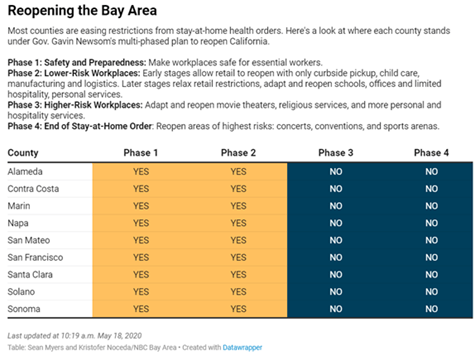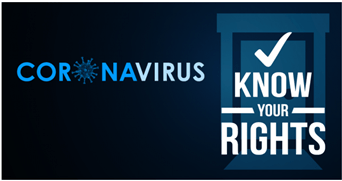COVID-19 Resources
Employees Rights and Returning to Work, Relief for Undocumented Workers
Two months since the Governor Newsom announced in early May that California counties would begin to enter into “Phase 2” of easing restrictions from shelter-in-place and reopening the economy.
Phase 2 allows childcare, manufacturing, logistics and retail (curbside pickup only) to reopen, with later stages relaxing retail restrictions and reopening schools, offices, some hospitality services, and dine-in restaurants. Among a long list of requirements that each county must document in order to enter into Phase 2 include:
- No deaths in 14 days;
- Minimum daily testing;
- Contract tracers;
- Hospital capacity for a surge; and,
- 14-day supply of PPE.
As of May 14, 2020, Sonoma, Napa, and Solano Counties are already operating in Phase 2 and are beginning to configure plans for “dine-in” restaurant options. As of May 18, 2020, all six Bay Area counties – Marin, San Francisco, San Mateo, Contra Costa, Alameda, and Santa Clara Counties have now entered into Phase 2.

Pursuant to Santa Clara County’s May 18, 2020 Amended Health Order, which was effective on May 22, 2020, retail stores and retail supply chain businesses may operate on a curbside/outside pickup or delivery basis only, and must have access to an “immediately adjacent sidewalk or outdoor pedestrian walkway, street, parking lot, or alley area for pick up by customers” so long as pedestrian access is not blocked and Social Distancing Requirements are still met. According to County Counsel, this means that while Stanford Shopping Center’s retail businesses are permitted to open due to their access to an outdoor pedestrian walkway or curb, those located inside Westfield Valley Fair are not.
What does this mean for employees whose employer plans to reopen, regardless of whether or not such plans are permitted by the County?
Below are some resources regarding employee safety, workers’ legal rights, and unemployment options to help navigate the latest uncertainties facing workers.
My employer is open or is in the process of reopening. What protocols and guidelines must they follow?
All businesses operating in the county which are visited by the public or personnel must prepare and follow a “Social Distancing Protocol” which must be provided to each employee of the facility. It must explain how the business is adhering to the Order’s requirement, which includes the following
- Training personnel on COVID-19 information, self-screening for symptoms, testing guidelines, how to prevent COVID-19 from spreading;
- Limiting the number of people who can enter into the facility at any one time to ensure that people in the facility can easily maintain a minimum six-foot distance from one another at all times;
- Requiring face coverings to be worn by all persons entering the facility;
- Where lines may form at a facility, marking six-foot increments at a minimum, establishing where individuals should stand to maintain adequate social distancing;
- Providing hand sanitizer, soap and water, or effective disinfectant at or near the entrance of the facility and in other appropriate areas for use by the public and personnel, and in locations where there is high-frequency employee interaction with members of the public (e.g., cashiers);
- Providing for contactless payment systems or, if not feasible to do so, the providing for disinfecting all payment portals, pens, and styluses after each use;
- Regularly disinfecting other high-touch surfaces;
- Posting a sign at the entrance of the facility informing all personnel and customers that they should: not enter the facility if they have any COVID-19 symptoms; maintain a minimum six-foot distance from one another; sneeze and cough into a cloth or tissue or, if not available, one’s elbow; wear a face covering to enter; and not shake hands or engage in any unnecessary physical contact; and
- Any additional social distancing measures being implemented (see the Centers for Disease Control and Prevention’s guidance at: https://www.cdc.gov/coronavirus/2019-ncov/community/guidance-business-response.html).
What if I am required to go back to work, but I do not think that it is safe to do so?
If your employer is now legally permitted to reopen its business but you do not feel safe returning:
You may qualify for Emergency Paid Sick Leave, which provides up to 2 weeks of paid leave to employees who are caring for someone who is subject to a quarantine or isolation order related to COVID-19, or who has been advised by a health care provider to self-quarantine. You may also qualify for Emergency Paid Sick Leave if you are currently working or voluntarily taking leave from work; in some areas of the state, this may only apply if your employer has less than 500 employees.
If your employer has illegally reopened its business or if your employer is in violation of mandatory health and safety conditions:
You may have protections under California Labor Code. Under Labor Code § 6311, an employee may refuse to perform unsafe work as long as it is hazardous enough that any reasonable person would think their health and safety was in danger.
Employees should offer to perform the work only if the employer is willing to accommodate to make the work safer, such as working from home or providing proper equipment. If the employer refuses to accommodate and the employee refused to work because it is reasonably unsafe to perform, employees should offer to perform other work that they consider safe.
OSHA – Hazardous Work Environment
The federal Occupational Safety and Health Act (the “OSH Act”) (28 U.S.C. § 654(a)(1)), employers must provide each worker “employment and a place of employment, which are free from recognized hazards that are causing or are likely to cause death or serious physical harm.” Any employer who attempts to force an employee to come into work, in spite of that employee’s justified self-quarantine or where another employee was a known carrier, may be acting in violation of the OSH Act.
ADA – Accommodations for Serious Health Conditions
Additionally, employees may have the right to take leave from work or perform remotely under the federal Americans with Disabilities Act of 1990 (42 U.S.C. § 12101 et seq.). According to the CDC, employees with a serious health condition—such as chronic lung disease, moderate to severe asthma, heart disease with complications immunocompromised systems including those who have received cancer treatment, people of any age with severe obesity, or those with certain related conditions like diabetes, renal failure, or liver disease—may cause them to be unusually susceptible to contracting COVID-19, and thus may be entitled to accommodations.
My employer is still requiring me to come to work in violation of the shelter-in-place order; can they fire me for not going to work?
If your employer requires you to come to work in violation of a government order to stay home, you may request COVID paid sick days so long as your employer has less than 500 employees.
If your employer fires you for not coming to work in compliance with a government order, you may have a claim for wrongful termination in violation of public policy.
An employee who refuses to be forced to work under hazardous circumstances may be protected from retaliation under Section 11(c) of the OSH Act (see above), which prohibits an employer from discriminating in any manner against an employee because they, among other things, exercised on their own behalf or on behalf of others any rights afforded under the OSH Act.
Do I have to disclose to my employer that I have a health condition (i.e. compromised immune system) that would be affected by COVID-19?
No. If your employer asks you whether you have a health condition that makes you vulnerable to contracting COVID-19, your answer may force you to disclose a disability. As such, your employer’s question is against the law. However, employees may choose to voluntarily disclose this information.
Additionally, employers may ask questions to determine whether the condition is a disability, discuss with you how the requested accommodation would assist and enable you to continue working, explore other ways the employer can effectively accommodate your needs, and request medical documentation if necessary
How much information can my employer request if I call in sick?
ADA-covered employers may ask you if you are experiencing the symptoms associated with COVID-19, which include fever, chills, cough, shortness of breath, or sore throat. As reputable sources, such as the CDC and other public health authorities, learn more about this pandemic, employers may use these sources as a guide to inquire about additional symptoms, such as loss of smell or taste or gastrointestinal problems.

I’m an “essential critical” or “critical infrastructure” worker – does the ADA and Rehabilitation Act apply to me?
Yes. The ADA and Rehabilitation Act are not superseded by CDC worker classifications. Employers receiving accommodation requests from essential critical or critical infrastructure workers must accept and process these requests just like any other employee; whether the request is granted will depend on whether the employee qualifies as having a disability and if a reasonable accommodation can be made absent an employer’s undue hardship. More information about the ADA, Rehabilitation Act, and EEOC guidelines can be found here.
I’m an undocumented worker; do I have any legal rights and remedies during this pandemic?
Generally, yes. Federal and California wage and hour laws generally apply to workers without legal immigration status. You are entitled to minimum wage, overtime pay, breaks, tips, and other forms of wages, and employers cannot suddenly refuse to pay you purely for lack of documentation.
Health and Safety
Undocumented workers also have health and safety rights; you may refuse to work if you reasonably believe it would create a real and apparent hazard to you or your co-workers, and you may file a health and safety claim with Cal/OSHA. Should Cal/OSHA choose to investigate your employer, they should not question you about your immigration statute nor report it if it is revealed at any point.
Unemployment/Disability
Although undocumented workers may not collect unemployment insurance, you can collect state disability insurance, so if you have suffered from a non-work related disability and paid into the state disability system, you may be entitled to receive as much as you contributed to the system. You will need proof of your medical condition from a doctor to qualify.
Disaster Relief for Undocumented Workers
The California Department of Social Services (CDSS) is providing one-time $500 grants to undocumented persons who are 19 and older, ineligible for federal COVID-19 assistance, and have experienced hardship as a result of the pandemic; a maximum of two people per household may receive this funding. No personal information will be shared with any government agency. Click here to apply. Additional sources of funding for undocumented workers can be found here.
For more information about state-sponsored relief, check out this Guide (in Spanish).
The information provided on this website does not, and is not intended to, constitute legal advice; instead, all information, content, and materials available on this site are for general informational purposes only. Readers should contact their attorney to obtain advice with respect to any particular legal matter. No reader, user, or browser of this site should act or refrain from acting on the basis of information on this site without first seeking legal advice from counsel in the relevant jurisdiction.
